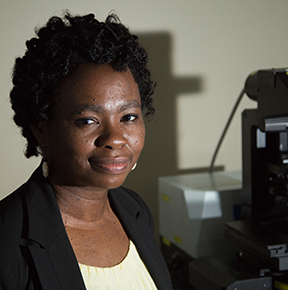Biological organisms can be re-engineered for singular purposes, such as production of biofuels, chemicals or pharmaceuticals, while computers are constructed to perform different and diverse tasks with simple downloads of new applications or software updates. An engineering professor at the University of Houston wants to marry the two concepts.
Elebeoba May, associate professor of biomedical engineering at the UH Cullen College of Engineering, earned the National Science Foundation’s Early Concept Grant for Exploratory Research, or EAGER, to explore programmable biological organisms. The goal of the two-year, $300,000 grant is to develop a framework through mathematical models and experimental work that moves the field of synthetic biology from reengineering-based programming to software-based programming.
May proposed that soft-programming of biological organisms has not yet happened. During the pioneer days of programmable computers, engineers hardwire “programmed” massive computer systems by physically moving wires, which is different from the programming that is happening with computers today, May said.
“My objective is to create the same type of evolution for engineered biological systems that happened for computer systems,” she said. “We are light years ahead when you look at where we started with computers.”
Much of May’s ongoing research focuses on multi-scale mathematical modeling for infectious diseases. For this project, she will draw on mathematical and experimental methods already developed in the May Multiscale Immunobiology Design Algorithms and Simulation (MIDAS) Lab at UH as well as established synthetic biology methods to enable software programming of biological systems. May’s team for this study includes two of her four doctoral students, Majid Latif and Danielle Stolley, as well as Komal Rasaputra, one of her two post-doctoral research scientists, all of whom work routinely in her lab.
“We want to modulate systems with specific inputs we supply, and prescriptively drive them to specific outcomes that we may not have observed before,” May said.
Synthetic biology incorporates existing metabolic and genetic engineering techniques to build databases of biological parts that are characterized and used in the design and engineering of various organisms with novel functionality, May said. During the last decade, the field of synthetic biology has grown rapidly with the creation of new tools by numerous researchers. Engineers have introduced metabolic pathways to organisms that have allowed them to perform new metabolic processes.
May and her team are studying Escherichia coli bacterial biofilms, which are communities of bacterial cells that grow together to form structures in a cooperative manner. The cells detect their environment through quorum sensing and two-component systems, which is the way they determine the relative size and state of their communities. They respond and perform functions based on this information.
“Biofilms are well-suited for the research because their structures allow us to observe interactions between bacterial cells in communities and to experiment with controlling them,” May said. “The findings could potentially help us engineer similar biological systems.”
Biofilms form on surfaces and inside people, and they are difficult to eliminate because of their structures. They can cause serious chronic infections in humans, and they can serve as contaminant sources in water supplies. An understanding of interactions in microbial communities can provide insight into ways to engineer therapeutic strategies to disrupt and eliminate cooperativity that is detrimental to human health and environmental systems, May said. The ability to interface with biological systems through a software base can also create possibilities for non-experts to engineer systems in novel ways, much like engineering novices develop innovative applications for smartphones.
“Another goal is for people with limited knowledge about the creation of synthetic microbes to do amazingly creative things with them,” May said. “The majority of individuals developing software applications for mobile devices have limited, if any, idea of how a microchip functions, but they are still able to develop intricate software applications to leverage the functionality of the integrated circuitry that runs computers. The dream is to make biological systems the next generation of microprocessors."
